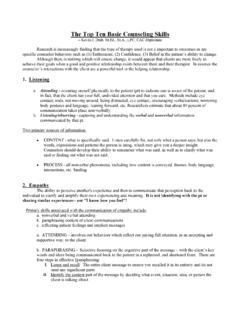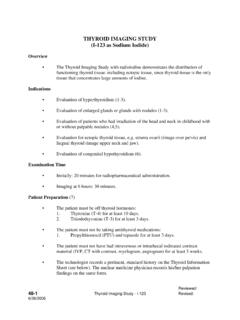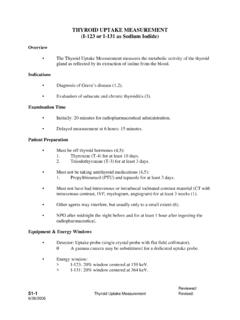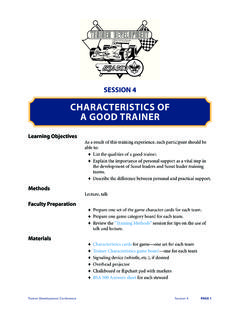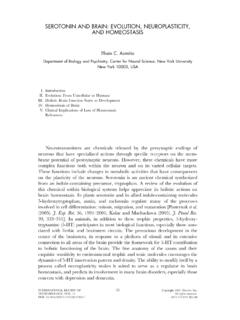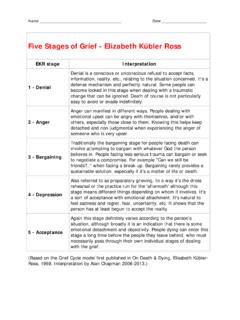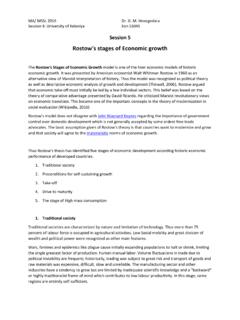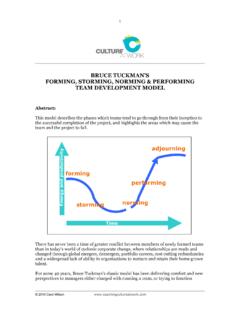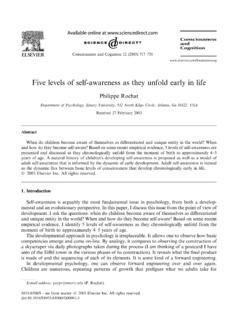Transcription of bruce w. tuckman - forming, storming norming and ...
1 Ideas thinkers practice bruce w. tuckman - forming , storming norming and performing in groups contents: introduction | storming , forming , norming and performing - developmental sequence in groups | a fifth stage - adjourning | assessment | conclusion | further reading and bibliography | links | how to cite this article bruce Wayne tuckman (1938- ) is probably best known for a short article - 'Developmental sequence in small groups' first published in 1965. However, the vast bulk of his published work has been concerned more broadly with educational research and educational psychology.
2 tuckman 's book Conducting Educational Research (first published in bruce W. tuckman produced one of the most quoted models of group development in the 1960s. We consider his contribution and the model's continuing ) has gone through five editions and his Theories and Applications of Educational Psychology (first published in 1996) is now in it's third edition. Currently bruce W. tuckman directs the Academic Learning Lab at Ohio State University (from 1998). Previously he had been a Professor of Educational Psychology at Florida State University (1983-98).
3 From 1965 to 1978 he held a variety of posts at Rutgers University before moving to the City University of New York. Currently bruce W. tuckman 's scholarly interest focuses on motivation: 'its manifestation in the form of self-regulatory behavior, and its absence in the form of procrastination, particularly as applied to the behavior of studying' ( tuckman 2003) . He is concerned with exploring the links between motivational factors and school achievement; and interventions that enhance the self-regulatory behaviour of students (such as goal setting, planning, and incentives).
4 bruce W. tuckman gained his Bachelor of Science from Renesselaer Polytechnic Institute in 1960, his Masters in Psychology from Princeton in 1962 and his PhD in 1963. He has also written a novel The Long Road to Boston (1988). forming , storming , norming and performing - developmental sequence in groups Even a quick glance at the literature of group development reveals a wide range of theoretical models concerning developmental processes. Most commentators assume that groups go through a number of phases or stages if they exist for an extended period.
5 It is clear, for example, that people tend to want to know something about the other members; Page 1 of 6bruce w. tuckman - forming , storming , norming and performing in groups10/19/2007 to develop a degree of interdependence in order that the group or team may achieve its tasks and be satisfying to its members; and has to learn at some level to deal with conflict if it is to survive. The most influential model of the developmental process - certainly in terms of its impact upon texts aimed at practitioners - has been that of bruce W.
6 tuckman (1965). While there are various differences concerning the number of stages and their names - many have adopted a version of tuckman 's model - forming , storming , norming and performing. He was later to add a fifth stage - adjourning ( tuckman and Jensen 1977). To begin we will look at his original formulation. The initial four- stage model evolved out of bruce W. tuckman 's observations of group behaviour in a variety of settings and his encounter with the literature. After completing his doctorate tuckman had worked with the industrial psychology lab at Princeton and then went on to undertake research on small-group and organizational behaviour as a Research Psychologist (GS-12) at the Naval Medical Research Institute, Bethesda MD.
7 (1963-65). At this point he argued that groups were likely to go through four distinct stages as they come to together and begin to function. These phases or stages might well be recognized in some way by participants - but there mat only be a limited consciousness of the changes and their implications. The obvious implication was that it people could develop a better appreciation of the processes surrounding group development then it would be possible to enhance group effectiveness and functioning. bruce W. tuckman describes the process as follows: My first professional job was as part of a small group of social psychologists in a think tank setting studying small group behavior as the US Navy prepared for a future of small crew vessels and stations.
8 Nine of us at the Naval Medical Research Institute were busy studying small groups from all perspectives and under all conditions. I was fortunate to have an experienced and talented boss by the name of Irwin Altman, who had been collecting every article he could find on group development. He turned his collection over to me and suggested that I look it over and see if I could make anything out of it. The collection contained 50 articles, many of which were psychoanalytic studies of therapy or T-groups. The task of organizing and integrating them was challenging.
9 After separating out two realms of group functioning, namely, the interpersonal or group structure realm and the task activity realm, I began to look for a developmental sequence that would fit the findings of a majority of the studies. I hit on four stages going from (1) orientation/testing/dependence, to (2) conflict, to (3) group cohesion, to (4) functional role-relatedness. For these I coined the terms: forming , storming , norming , and performing ( tuckman 1984) This is how tuckman described the stages in the original article: Groups initially concern themselves with orientation accomplished primarily through testing.
10 Such testing serves to identify the boundaries of both interpersonal and task behaviors. Coincident with testing in the interpersonal realm is the establishment of dependency relationships with leaders, other group members, or pre-existing standards. It may be said that orientation, testing and dependence constitute the group process of forming . Page 2 of 6bruce w. tuckman - forming , storming , norming and performing in groups10/19/2007 second point in the sequence is characterized by conflict and polarization around interpersonal issues, with concomitant emotional responding in the task sphere.
